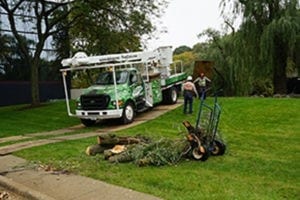Intense Storms Necessitate Tree Removal Before an Emergency
This time of year, Mother Nature can throw almost anything at us. April hangs out at the border between Winter and the warmer months. For that reason, the weather can be volatile. It’s not unusual for the month to roar in with a snowstorm or ice storm, and for us to see temps warm enough for thunderstorms a few days or weeks later. From the month’s end, it’s just a hop, skip, and a jump into summer’s intense thunderstorms.
All of this violent weather activity can wreak havoc on trees already damaged or weakened by drought, disease, insect infestation, or winter’s snow. Because storms can sweep in quickly, it’s crucial that you identify trees requiring removal before the weather creates an emergency.
What should you look for when checking your trees? We’ve provided a few of the most common signs you might need tree removal. If you’d like to know more, or if you identify a tree that you think might be removed, you should call on a professional tree removal service. At Advanced Tree Care, our staff includes certified arborists experienced in helping make that decision with you.

Common Signs You Might Need Tree Removal
Examine roots
Some trees grow stem girdling roots. These are roots at or below the soil surface, and they partially or completely encircle the tree’s trunk. Over time, the growth of these roots can affect the health of the tree and its root system and contribute to trunk weakness. This weakness can result in a toppled tree. Trees with a tendency to form stem girdling roots include Norway maples, silver maples, poplars (black & white), littleleaf lindens, and red maples.
Look at the trunk
Obvious signs of decay or damage on the trunk should always be a reason for concern. The trunk is the tree’s longest and strongest structure. A lack of support can spell disaster the next time a storm strikes, so don’t delay in calling in professional service when you notice signs of decay.
Check for weak branches
Certain trees are prone to forming inclusions of bark where tree limbs meet. In normal growth, there is a protruding ridge of bark line where the limbs meet. When there isn’t, you know you’ve spotted an inclusion of bark. These areas are weaker and may split off during a storm. Box elder trees, silver maples, littleleaf lindens, red maples, and willow trees are among those most prone to this condition.
Additionally, all trees may form weak, narrow, v-angled crotches where certain branches meet. It’s a good idea to check your trees regularly and have them pruned to protect against sudden storm damage at these weak spots.
Take precautions with certain species
Fast-growing, soft-wooded trees can be especially vulnerable to high winds and storm damage. These include weeping willows and silver maples, among others. A certified arborist can discuss options with you to protect trees in advance of storms, or help you decide when removal is the best option for your protection.
Identify signs of infestation
Certain diseases or insect infestations can structurally damage your tree, rendering it more vulnerable to storm damage. Leaf damage, trunk damage, and active bugs or beetles present on the bark and in the wood can all be clues that your tree is infested. One of our professional staff will be able to help you determine what is going on, and whether the tree can be treated or must be removed. Remember, infestation and disease can spread to other trees, so don’t delay if you do notice signs.
Of course, if a storm has already damaged your tree, or if it’s already downed, you’ll want to call for emergency tree removal service right away. We maintain a 24/7 emergency line with fast response time for just such situations. Keep children and pets a safe distance away from your tree and don’t attempt to remove it yourself.
Advanced Tree Care combines top-notch equipment, cutting-edge technology, and well-trained staff to provide emergency tree removal and tree maintenance services. With a presence in nine counties and two states, we work daily to provide unparalleled customer service, safety, and efficiency—as well as the expertise to beautify your landscaping and community. Advanced Tree Care isn’t just our name—it’s also our purpose!